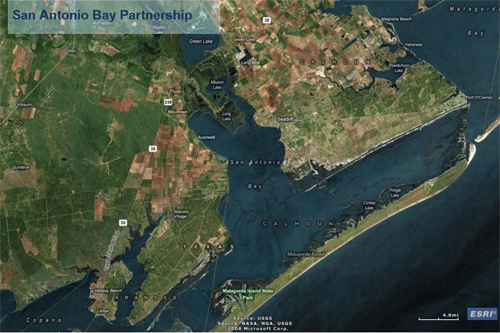San Antonio Bay has a way of stirring up trouble: shrimping wars, industrial waste disputes, and environmental lawsuits.
Still, some bay stakeholders believe that working together is a better way to calm the troubled waters than working at odds. These stakeholders formed the nonprofit San Antonio Bay Partnership to find common ground among all who rely on the bay – people and the environment.
“We want to bring everyone to the table,” said John Kisalus, board chair of the San Antonio Bay Partnership. “We are confident that our goodwill and inclusive, scientific approach will build on the recent efforts of state-appointed stakeholders and the future outcome of the whooping crane lawsuit.”
In 2010 the San Antonio Bay Partnership was created by interested parties to develop a management plan that protects, restores and enhances the bay and estuary to benefit the environment and people. Similar management plans have been developed for Galveston and Corpus Christi bay systems.
Now the San Antonio Bay Partnership faces the biggest opportunity yet to help residents, landowners, businesses, recreationists, municipalities, river authorities and government agencies balance their needs with those of the environment. The Partnership aims to develop a bay management plan that bridges basic differences about San Antonio bay health that couldn’t be bridged before.
“Vested interests have a lot at stake in San Antonio Bay,” Kisalus acknowledged. “But we believe that a collaborative process is more promising that polarized arguments.”
In 2010 The Aransas Project – an alliance of environmental groups, businesses, municipalities, political parties and individuals – sued the Texas Commission on Environmental Quality on grounds that it failed to allow enough fresh water to flow into San Antonio Bay to protect the endangered Whooping Cranes. A decision is still pending.
The stakes are rising for San Antonio Bay. The estuary system relies on fresh water flowing in from the Guadalupe and San Antonio rivers, which face growing water demands upstream. Both quantity and timing matter.
Earlier this year, a panel of state-appointed stakeholders made recommendations to the TCEQ about how much water should flow into San Antonio Bay to maintain a sound ecological environment while considering and balancing public interests in water supply. The stakeholders failed to reach a consensus on their recommendations, and some felt the subsequent rules developed by TCEQ were inadequate.
“Both the TCEQ stakeholder process and the whooping crane trial recognized the need for more information,” said Kisalus. “That’s where we can play a role, for example, if a crane conservation plan is required by a court decision in the whooping crane lawsuit.”
The San Antonio Bay Partnership could help TCEQ and other agencies implement a work plan for additional studies and activities developed by the state-appointed stakeholders, said James Dodson, facilitator for the Partnership. The work plan covers San Antonio, Mission, Copano and Aransas bays.
Other pressures on the San Antonio Bay system include:
• Population growth along the coast and inland
• Pollution from non-specific points
• More frequent droughts
• Warming air and water temperatures
• Invasive plant and animal species
• Rising sea levels
Stakeholders in the San Antonio Bay Partnership represent a wide range of interests: the public, landowners, businesses, recreational and professional fishing, water recreationists, bird watchers, municipalities, river authorities, state and federal agencies.
The aim of the Partnership is to balance these human interests with those of the environment through a consensus building process, rather than an adversarial one.
“We realize that competition for water is growing,” Kisalus said. “New ideas and willingness to innovate are needed if we are to make more effective and efficient use of our limited water resources.”
The Partnership focuses its efforts in four areas:
• Assessing the health of the bay through evaluations of the current status and trends of key ecological parameters (i.e., salinity and water quality; shellfish, fish and bird populations; and marshland habitat);
• Identifying potential sites for habitat protection, restoration and enhancement;
• Locating potential sites for public access and encouraging ecotourism activities;
• Coordinating with other coastal and watershed groups involved in assuring the environmental and economic health of bays and estuaries.
To raise public awareness of its efforts, the San Antonio Bay Partnership is holding “SA Bay Day” on the Seadrift waterfront on Sept. 29. The public is invited to participate in a variety of water and shore side activities, in coordination with other coastal organizations in the region to celebrate National Estuaries Day.
For details, visit www.sabaypartnership.org
“This is one of the most pristine bays on the Texas Coast,” said Roy Foley, vice chair of the San Antonio Bay Partnership board and Professor of Education at University of Houston-Victoria. “Among other benefits it provides, it is the winter home for the world’s last wild flock of Whooping Cranes. We need to be good stewards.”
About the San Antonio Bay Partnership
The San Antonio Bay Partnership was formed to develop and implement a management plan for San Antonio Bay and the Guadalupe Estuary through public and stakeholder involvement and scientific research. The plan will be a comprehensive, science-based “blueprint” for protecting, restoring and enhancing both the ecological resources and the human uses of the San Antonio Bay/Guadalupe Estuary System.
The public is invited to participate in all meetings and activities of the San Antonio Bay Partnership. For information on these events, please check the website frequently: www.sabaypartnership.org



